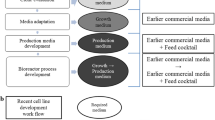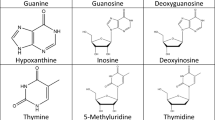Abstract
A serum-free medium, WCM5, has been developed for the large scale propagation of CHO (Chinese hamster ovary) cells which express recombinant protein using dihydrofolate reductase as a selectable marker. WCM5 was prepared by supplementing Iscoves medium without lecithin, albumin or transferrin with a number of components which were shown to benefit growth. WCM5 medium contained 5 mg l−1 human recombinant insulin (Nucellin) but was otherwise protein-free. CHO 3D11* cells which had been engineered to express a humanised antibody, CAMPATH*-1H, were routinely grown using serum-containing medium. From a seeding density of 105 cells ml−1, cells grown in static culture with serum reached a maximal cell density of 6.5×105 cells ml−1 after 6 days in culture and produced a maximal antibody concentration of 69 mg l−1 after 11 days in culture. CHO 3D11* cells grown with serum were washed in serum-free medium then cultured in WCM5 medium. Following a period of adaptation the cell growth and product yield was superior to that achieved with serum-containing medium. CHO cells producing CAMPATH-1H grown in an 8000 l stirred bioreactor seeded with 2×105 cells ml−1 reached a maximal viable cell density of 2.16×106 cells ml−1 after 108 h in culture and a maximal antibody concentration of 131.1 mg l−1 after 122 h in culture.
Similar content being viewed by others
Abbreviations
- CHO:
-
Chinese hamster ovary
- dhfr:
-
dihydrofolate reductase
- dhfr:
-
dihydrofolate reductase deficient
- MTX:
-
methotrexate
- H:
-
hypoxanthine
- T:
-
thymidine
- T/V:
-
trypsin versene
- F12:
-
Hams F12 medium
- NEAA:
-
non essential amino acids
References
Campisi J and Pardee AB (1984) Post-transcriptional control of the onset of DNA synthesis by an Insulin-like Growth Factor. Mol. Cell Biol. 4: 1809–1814.
Gasser F, Mulsant P and Gillois M (1985) Long-term multiplication of the Chinese hamster ovary (CHO) cell line in a serum-free medium. In Vitro 21(10): 588–592.
Gillies SD, Dorai H, Wesolowski J, Majeau G, Young D, Boyd J, Gardner J and James K (1989) Expression of human antitetanus toxoid antibody in transfected murine myeloma cells. Bio/Technology 7: 799–804.
Hale G, Cobbold SP and Waldmann H (1988a) T-cell depletion with Campath 1H antibodies in allogeneic bone marrow transplantation. Transplantation 45: 753–759.
Hale G, Dyer MJS, Clark MR, Philips JM, Marcus R, Reichmann L, Winter G and Waldmann H (1988b) Remision induction in non-Hodgkins lymphoma with reshaped human monoclonal antibody, CAMPATH-1H. Lancet 2: 1394–1399.
Hale G, Xia M-Q, Tighe HP, Dyer MJS and Waldmann H (1990) The CAMPATH-1H antigen (CDw52). Tiss. Antigens 35: 118–127.
Ham RG (1965) Clonal growth of mammalian cells in a chemically defined, synthetic medium. Proc. Natl. Acad. Sci. USA 53: 288–293.
Hamilton WG and Ham RG (1977) Clonal growth of Chinese hamster cell lines in protein-free media. In Vitro 13(9): 537–547.
Handa A, Emery AN and Spier RE (1987) On the evaluation of gas-liquid interfacial effects on hybridoma viability in bubble column bioreactors. Develop. Biol. Standard. 66: 241–252.
Holtta E and Pohjanpelto P (1983) Polyamine starvation causes accumulation of cadaverine and its derivatives in a polyamine-dependent strain of Chinese-hamster ovary cells. Biochem. J. 210: 945–948.
Isaacs JD, Watts RA, Hazleman BL, Hale G, Keogan MT, Cobbold SP and Waldman H (1992) Humanised monoclonal antibody therapy for rheumatoid arthritis. The Lancet 340: 748–752.
Kao FT and Puck TT (1968) Genetics of somatic mammalian cells, VII. Induction and isolation of nutritional mutants in Chinese hamster cells. Proc. Natl. Acad. Sci. USA 60: 1275–1281.
Kaufman RJ, Wasley LC, Spilotes SD, Gossels SD, Latt SA, Larsen GR and Kay RM (1985) Coamplification and coexpression of human tissue type plasminogen activator and murine dihydrofolate reductase sequances in Chinese hamster ovary cells. Mol. Cell. Biol. 5: 1750–1759.
Kovar J (1988) Growth-stimulating effect of ferric citrate on hybridoma cells: characterization and relation to transferrin function. Hybridoma 7(3): 255–263.
Martin SJ, Mazdai G, Strain JJ, Cotter TG and Hannigan BM (1991) Programmed cell death (apoptosis) in lymphoid and myeloid cell lines during zinc deficiency. Clin. Exp. Immunol. 83: 338–343.
Merten OW and Litwin J (1991) Serum-free medium for fermentor cultures of hybridomas. Cytotechnology 5: 69–82.
Page MJ and Sydenham MA (1991) High level expression of the humanised monoclonal antibodiy Campath 1H in Chinese hamster ovary cells. Bio/Technology 9: 64–68.
Riechmann L, Clark M, Waldman H and Winter G (1988) Reshaping human antibodies for therapy. Nature 332: 323–327.
Shane B and Stockstad EL (1985) Vitamin B12-folate interelationship. Annu. Rev. Nutr. 5: 115–141.
Shintani Y, Iwamoto K and Kitano K (1988) Polyethylene glycols for promoting the growth of mammalian cells. Appl. Microbiol. Biotechnol. 27: 533–537.
Stryer L (1988) Biochemistry. Third Ed. Freeman Press, New York, USA.
Traunecker A, Filipo O and Karajalainen K (1991) Myeloma based expression system for production of large mammalian proteins. Tibtech. 9: 109–113.
Urlaub G and Chasin LA (1980) Isolation of Chinese hamster ovary cell mutants deficient in dihydrofolate reductase activity. Proc. Natl. Acad. Sci. USA 77(7): 4216–4220.
Zettlmeissel G, Ragg H and Karges HE (1987) Expression of biologically active antithrombin III in Chinese hamster ovary cells. Bio/Technology 5: 720–725.
Author information
Authors and Affiliations
Rights and permissions
About this article
Cite this article
Keen, M.J., Rapson, N.T. Development of a serum-free culture medium for the large scale production of recombinant protein from a Chinese hamster ovary cell line. Cytotechnology 17, 153–163 (1995). https://doi.org/10.1007/BF00749653
Received:
Accepted:
Issue Date:
DOI: https://doi.org/10.1007/BF00749653




